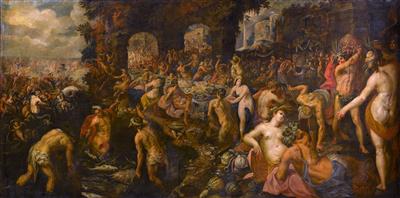Gillis van Valckenborch

(Antwerp c. 1570–1622 Frankfurt am Main)
Banquet of the Gods,
signed and dated: Gilis.van.valckenborch./.1597., monogrammed above: G/vv,
oil on canvas, 135 x 274 cm, framed
Provenance:
Pogatschnig Collection, Turin, and descendants (1963–2011);
European private collection
Literature:
G. T. Faggin, De gebroeders Frederik en Gillis van Valckenborch, in: Bulletin Museum Boijmans van Beuningen XIX, no. 1., Rotterdam, 1963, pp. 1–16, p. 10, fig. 9
The painting is accompanied by a certificate from Prof. Alexander Wied.
We are grateful to Dr. Alexander Wied for having examined the present painting in the original and confirming it as an autograph work by Gillis van Valckenborch.
According to Alexander Wied the present painting is one of the masterpieces of the artist’s maturity.
Here Valckenborch displays his artistic virtuosity by arranging female and male nudes in various poses, while simultaneously keeping the overall composition in balance, despite the crowd of figures depicted. Even the clouds in the upper-left corner are populated by figures: Apollo appears on his sun chariot, drawn by four horses.
Wied assumes that this Banquet of the Gods also contains an allegory of the Four Elements as a second layer of content: accordingly, Water would be symbolized by the helpers carrying a fishing net, whereas Bacchus and Ceres, appearing on the left-hand side surrounded by gourds, would personify Earth; and the above mentioned Apollo in his quadriga would be an embodiment of Air. According to this interpretation, only Fire would play a subordinate role here, for it would merely be alluded to by the fire kettle right of centre. Only some forty works from the oeuvre of Gillis van Valckenborch are known to date, with the present painting being one out of only seven that are both signed and dated. The date of 1597 suggests that the present composition was painted upon the artist’s return from his journey to Italy, which presumably ended in 1596. Besides Italian influences, the work also reveals borrowings from a popular engraving by Hendrick Goltzius based on Bartholomeus Spranger’s Marriage of Cupid and Psyche from 1587, shown in the back views of female nudes. Wied also proposes Spranger’s Hercules and Omphale (Kunsthistorisches Museum, Vienna) as another possible comparison, for the rear view of one of the female nudes, with its delicately curved back, which corresponds to that of Omphale. This latter painting dates from the mid-1580s; however, it is unclear if and how Valckenborch could have seen it in the collection of Rudolf II.
We are grateful to Dr. Alexander Wied for his assistance in cataloguing the present painting.
15.10.2013 - 18:00
- Dosažená cena: **
-
EUR 158.900,-
- Odhadní cena:
-
EUR 150.000,- do EUR 200.000,-
Gillis van Valckenborch
(Antwerp c. 1570–1622 Frankfurt am Main)
Banquet of the Gods,
signed and dated: Gilis.van.valckenborch./.1597., monogrammed above: G/vv,
oil on canvas, 135 x 274 cm, framed
Provenance:
Pogatschnig Collection, Turin, and descendants (1963–2011);
European private collection
Literature:
G. T. Faggin, De gebroeders Frederik en Gillis van Valckenborch, in: Bulletin Museum Boijmans van Beuningen XIX, no. 1., Rotterdam, 1963, pp. 1–16, p. 10, fig. 9
The painting is accompanied by a certificate from Prof. Alexander Wied.
We are grateful to Dr. Alexander Wied for having examined the present painting in the original and confirming it as an autograph work by Gillis van Valckenborch.
According to Alexander Wied the present painting is one of the masterpieces of the artist’s maturity.
Here Valckenborch displays his artistic virtuosity by arranging female and male nudes in various poses, while simultaneously keeping the overall composition in balance, despite the crowd of figures depicted. Even the clouds in the upper-left corner are populated by figures: Apollo appears on his sun chariot, drawn by four horses.
Wied assumes that this Banquet of the Gods also contains an allegory of the Four Elements as a second layer of content: accordingly, Water would be symbolized by the helpers carrying a fishing net, whereas Bacchus and Ceres, appearing on the left-hand side surrounded by gourds, would personify Earth; and the above mentioned Apollo in his quadriga would be an embodiment of Air. According to this interpretation, only Fire would play a subordinate role here, for it would merely be alluded to by the fire kettle right of centre. Only some forty works from the oeuvre of Gillis van Valckenborch are known to date, with the present painting being one out of only seven that are both signed and dated. The date of 1597 suggests that the present composition was painted upon the artist’s return from his journey to Italy, which presumably ended in 1596. Besides Italian influences, the work also reveals borrowings from a popular engraving by Hendrick Goltzius based on Bartholomeus Spranger’s Marriage of Cupid and Psyche from 1587, shown in the back views of female nudes. Wied also proposes Spranger’s Hercules and Omphale (Kunsthistorisches Museum, Vienna) as another possible comparison, for the rear view of one of the female nudes, with its delicately curved back, which corresponds to that of Omphale. This latter painting dates from the mid-1580s; however, it is unclear if and how Valckenborch could have seen it in the collection of Rudolf II.
We are grateful to Dr. Alexander Wied for his assistance in cataloguing the present painting.
|
Horká linka kupujících
Po-Pá: 10.00 - 17.00
old.masters@dorotheum.at +43 1 515 60 403 |
| Aukce: | Obrazy starých mistr? |
| Typ aukce: | Salónní aukce |
| Datum: | 15.10.2013 - 18:00 |
| Místo konání aukce: | Wien | Palais Dorotheum |
| Prohlídka: | 05.10. - 15.10.2013 |
** Kupní cena vč. poplatku kupujícího a DPH
Není již možné podávat příkazy ke koupi přes internet. Aukce se právě připravuje resp. byla již uskutečněna.
